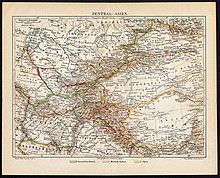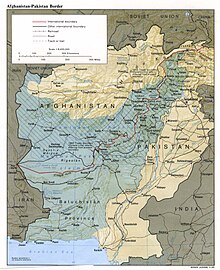Durand line
The Durand Line is an imprecise, 2,450 kilometer long demarcation line between Afghanistan and Pakistan .
After the first two British-Afghan Wars , the British Empire succeeded in delimiting its colonial possessions in British India (now Pakistan) from the Emirate of Afghanistan in 1872 with the Frontier Crimes Regulation and in 1893 with the Durand Line . The line was named after the then foreign minister of the Indian administration, Henry Mortimer Durand , and was decided by mutual agreement under British pressure. The demarcation line was deliberately placed through the settlement areas of the Pashtuns , which led to the fact that some tribes of the Pashtuns, such as the Kharoti, divided and hundreds of Afghan villages separated. About a third of the Afghan territory fell to the British. Furthermore, the British colonial power pursued the goal of better protecting the north-western border of their territory, what was then British India, against the expanding Tsarist Russia by establishing a strategic buffer zone .
In 1947 the state of Pakistan was founded with the inclusion of Pashtun areas. The Afghan Loja Jirga of 1949 then declared the Durand Line to be invalid because the original agreement had been concluded with the British and not with the Pakistani government; the Vienna Convention on the Law of Treaties , according to which a bilateral treaty cannot be challenged by unilateral contradiction, has not been ratified by either Afghanistan or Pakistan . Occasionally, it is said that the treaty had expired in 1993 and that the Durand Line is no longer the official border between the states of Afghanistan and Pakistan. However, the contract did not contain a time limit and could therefore not expire. In view of the controversial situation, NATO and ISAF also speak of an AfPak region .
The demarcation line, which can hardly be monitored, moved back into public awareness in the wake of the war on terrorism after the attacks of September 11, 2001 . Taliban fighters and Al Qaeda supporters moved relatively unhindered in the area and found refuge in the autonomous Pashtun regions in Pakistan. The establishment of an official border is therefore of enormous importance for the further peace and stability of both countries and plays a key role in the peace negotiations.
Web links
- The creation of the Durand line: account of Algernon Durand, British officer and brother of Henry M. Durand
- Durand Line and Pashtunistan
- Durand line on afghanland.com (English)
- Durand line on www.irinnews.org (English)
Individual evidence
- ↑ Habibo Brechna: The History of Afghanistan . 2nd Edition. vdf Hochschulverlag AG, Zurich 2012, ISBN 3-7281-3391-4 .
- ↑ http://afghanic.de/images/Docs/Durand%20Line%20Agreement.pdf Durand Line Agreement November 12, 1893, accessed on December 17, 2014

